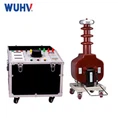The main function of Current Transformers (CTs) and Potential Transformers (PTs) is to accurately measure and transform high currents and voltages, respectively, into values that are suitable for metering, protection, and control in electrical power systems. Here's a breakdown of the main functions of CTs and PTs:
Current Transformers (CTs):
Current Measurement:
CTs are designed to measure high currents flowing in power lines and electrical equipment. They transform these high currents into a proportionally lower current that can be safely and accurately measured by instruments.
Instrumentation:
The reduced current output from a CT is used by various instruments, such as ammeters, energy meters, and protective relays, for monitoring and control purposes.
Protection:
CTs play a critical role in protective relaying. They provide current inputs to protective relays, which monitor the current flow and initiate protective actions in the event of faults or abnormal conditions.
Metering:
CTs are essential for accurate metering of electrical energy consumption. They provide current inputs to energy meters, allowing utilities and consumers to measure and bill electricity usage.
Isolation:
CTs provide electrical isolation between the high-voltage primary side and the low-voltage secondary side. This isolation is crucial for the safety of personnel and equipment.
Potential Transformers (PTs):
Voltage Measurement:
PTs measure high voltages in power systems and step them down to a lower, proportionate voltage suitable for instrumentation and control.
Instrumentation:
The reduced voltage output from a PT is used by various instruments, such as voltmeters and protective relays, for monitoring and control purposes.
Protection:
PTs provide voltage inputs to protective relays, which monitor voltage levels and initiate protective actions in response to abnormal conditions or faults.
Metering:
PTs are crucial for accurate metering of electrical parameters, such as voltage and power factor. They provide voltage inputs to energy meters, contributing to accurate billing and monitoring.
Isolation:
Similar to CTs, PTs provide electrical isolation between the high-voltage primary side and the low-voltage secondary side. This isolation enhances safety and protects equipment.
Control Systems:
PTs contribute to the control of various electrical devices by providing accurate voltage information. This is essential for maintaining proper voltage levels and ensuring the stability of the power system.
In summary, the main functions of CTs and PTs involve accurate measurement, transformation, and provision of inputs for various instruments and protective devices in power systems. They play a crucial role in ensuring the safe, reliable, and efficient operation of electrical grids. Additionally, when CTs and PTs are combined into a single unit (CTPT), they provide a compact solution for comprehensive current and voltage measurement in power systems.




